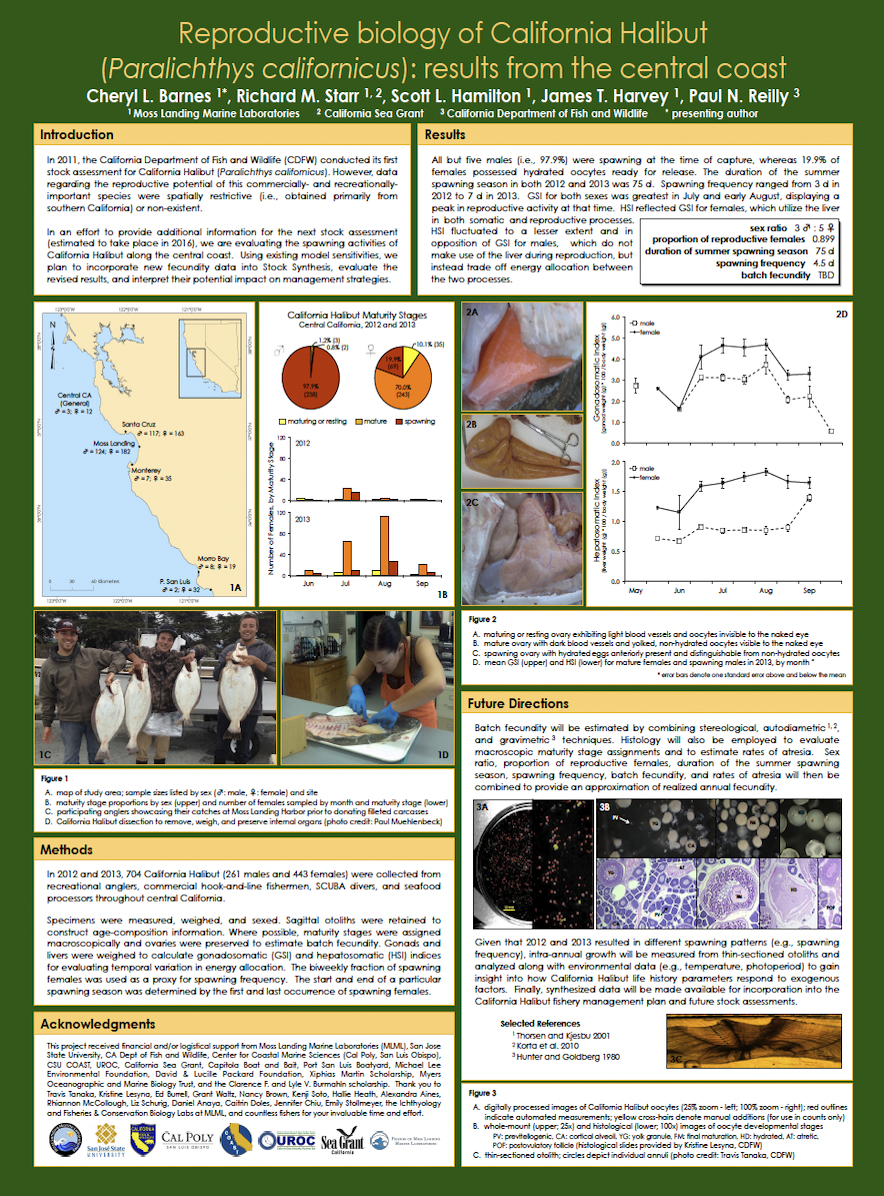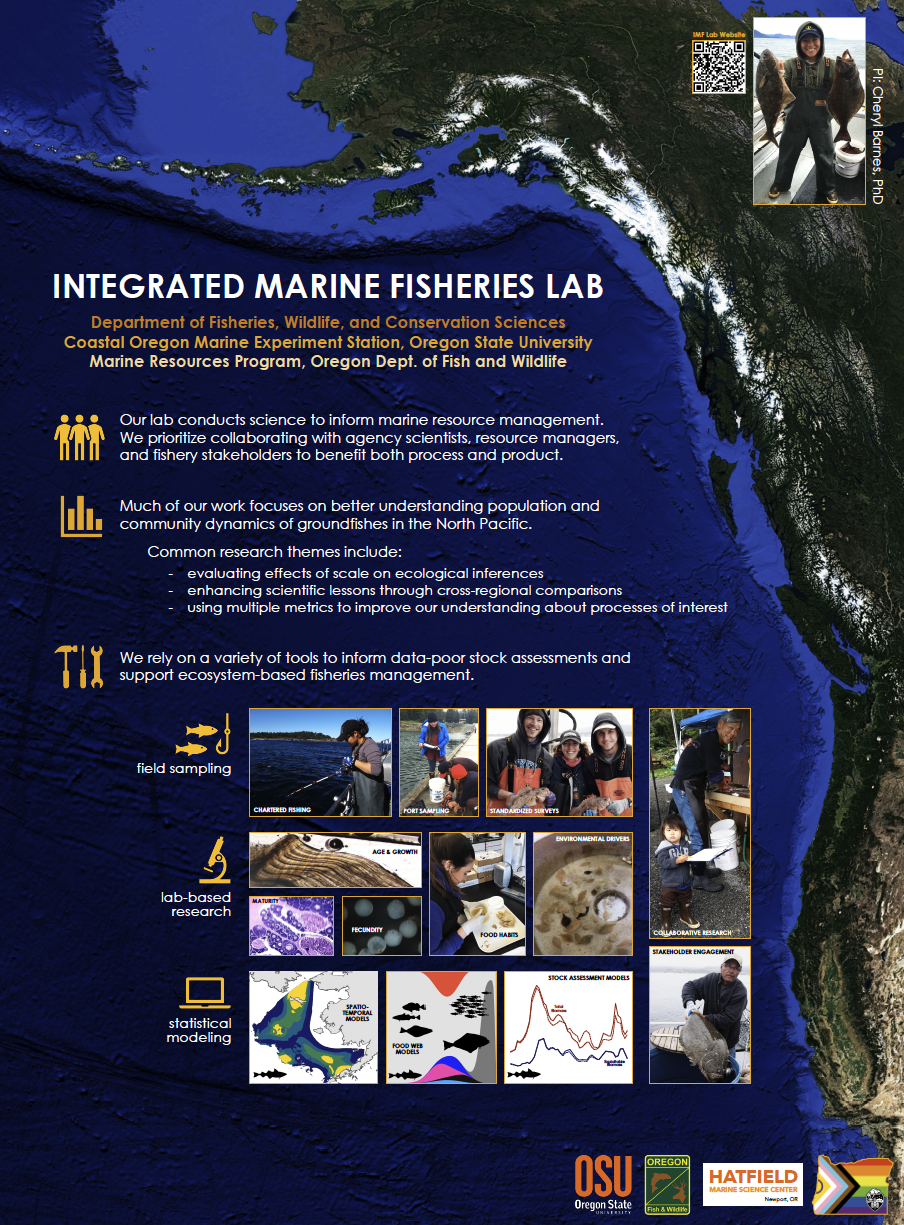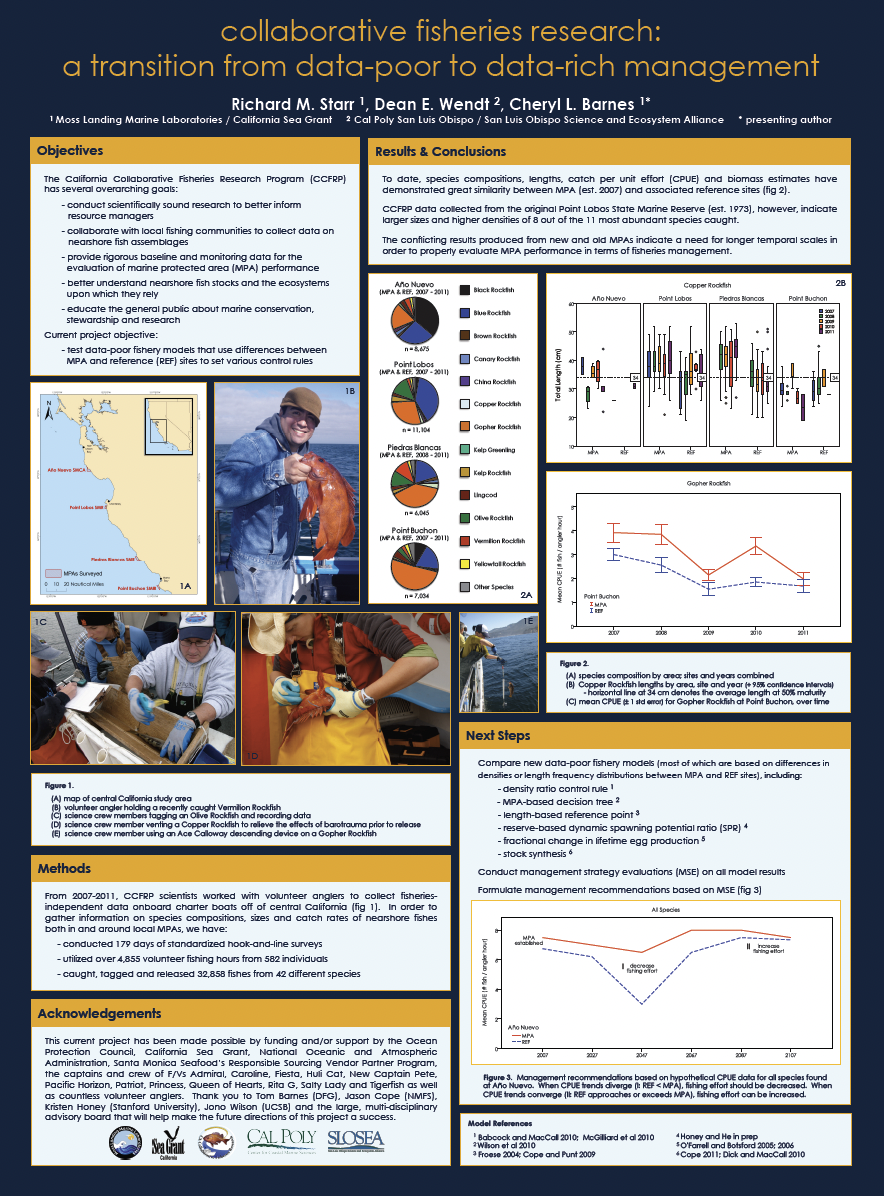Scientific findings from shared resources should be made accessible to everyone. Thus, the IMF Lab prioritizes publishing open access to make our work available free of charge. Please contact us if you have trouble accessing any of the publications listed below.
PEER-REVIEWED PUBLICATIONS
The projects below were also highly collaborative...so please be sure to check out the acknowledgments sections, which credit people who contributed but are not listed as coauthors. Please also click here for a list of research assistants who we have worked with along the way. Many are also highlighted in the photo gallery.
Published, In Press, or Accepted
— Rovellini A, Punt AE, Dorn MW, Kaplan IC, Bryan MD, Adams GD, Aydin KY, Baker MR, Barnes CL, Ferriss BE, Fulton EA, Haltuch MA, Hermann AJ, Holsman KK, McGilliard C, McHuron EA, Morzaria-Luna HM, and Surma S. 2025. Evaluating ecosystem caps on fishery yield in the context of climate stress and predation. Ecological Applications. 35(3):eap70036.
— Goodman MC, Reum JCP, Barnes CL, Punt AE, Ianelli JN, McHuron EA, De Leo GA, and Holsman KK. 2024. Climate covariate choice and uncertainty in projecting species range shifts: a case study in the Eastern Bering Sea. Fish and Fisheries. 26:219-239.
— Kerametsidis G, Thorson J, Rossi V, Álvarez-Berastegui D, Barnes CL, Certain G, Esteban A, García E, Jadaud A, Piñeiro S, Vivas M, and Hidalgo M. 2024. Cross-scale environmental impacts across persistent and dynamic aggregations within a complex population: implications for fisheries management. Can J Fish Aquat Sci. 81(3):268-284.
— Thorson JT, Barnes CL, Friedman ST, Morano JL, and Siple MC. 2023. Spatially varying coefficients can improve parsimony and descriptive power for species distribution models. Ecogr. e06510.
— Brodie S, Smith JA, Muhling BA, Kaplan IC, Barnett LAK, Carroll G, Fiedler P, Bograd SJ, Hazen EL, Jacox MG, Andrews KS, Barnes CL, Crozier L, Fiechter J, Fredston A, Haltuch MA, Harvey CJ, Holmes E, Karp MA, Liu OR, Malick MJ, Buil MP, Richerson K, Rooper CN, Samhouri J, Seary R, Selden RL, Thompson AR, Thorson J, Tommasi D, Ward EJ, and Zabel R. 2022. Recommendations for quantifying and reducing uncertainty in projections of species distributions. Glob Change Biol. 28:6586-6601.
— Barnes CL, Essington TE, Pirtle JL, Rooper CN, Laman EA, Holsman KK, Aydin KY, and Thorson JT. 2022. Climate-informed models benefit hindcasting but present challenges when forecasting species-habitat associations. Ecogr. e06189.
— Dorn MW and Barnes CL. 2022. Time-varying predation as a modifier of constant natural mortality for Gulf of Alaska pollock. Fish Res. VSI Natural Mortality. 254(2022):106391.
— Barnes CL, Beaudreau AH, and Yamada RN. 2021. The role of size in trophic niche separation between two groundfish predators in Alaskan waters. Mar Coast Fish. 13:69-84.
— Grüss A, Thorson JT, Stawitz CC, Reum JCP, Rohan SK, and Barnes CL. 2021. Synthesis of interannual variability in spatial demographic processes supports the strong influence of cold-pool extent on eastern Bering Sea walleye pollock (Gadus chalcogrammus). Progr Ocean. 194(2021):102569.
— Barnes CL, Beaudreau AH, Dorn MW, Holsman KK, and Mueter FJ. 2020. Development of a predation index to assess trophic stability in the Gulf of Alaska. Ecol Appl. 30(7):e02141.
— Barnes CL, Beaudreau AH, Hunsicker ME, and Ciannelli L. 2018. Assessing the potential for competition between Pacific Halibut (Hippoglossus stenolepis) and Arrowtooth Flounder (Atheresthes stomias) in the Gulf of Alaska. PLoS ONE. 13(12):e0209402.
— Barnes CL and Starr RM. 2018. Reproductive tactics of California Halibut (Paralichthys californicus): combining spawning season, interspawning interval, and batch fecundity to estimate annual reproductive output for a multiple-batch spawning fish. CalCOFI Rep. 59:102–114.
— Lesyna KM and Barnes CL (corresponding author). 2016. Assessment of length- and age-at-maturity for California Halibut (Paralichthys californicus), including a histologically-based description of the reproductive cycle. Calif Fish Game. 102(3):79–99.
— Barnes CL, Starr RM, and Reilly PN. 2015. Growth, mortality, and reproductive seasonality of California Halibut (Paralichthys californicus): a biogeographic approach. CalCOFI Rep. 56:110–118.
— Starr RM, Wendt DE, Barnes CL, Marks CI, Malone D, Waltz G, Schmidt KT, Chiu J, Launer AL, Hall NC, and Yochum N. 2015. Variation in responses of fishes across multiple reserves within a network of marine protected areas in temperate waters. PLoS ONE. 10(3):e0118502.
— Starr RM, Cortés J, Barnes CL, Green K, and Breedy O. 2012. Characterization of deepwater invertebrates at Isla del Coco National Park and La Gemelas Seamount, Costa Rica. Int J Trop Biol. 60(3):303–319.
In Revision, In Review, or Submitted
In Preparation STOCK ASSESSMENTS & STAR PANEL REPORTS RESEARCH APPLICATIONS SELECT CONFERENCE PRESENTATIONS
— Vivitskaia JD Tulloch, Murray C, Surma S, Barnes CL, Conn J, Holsman K, Martin T, Morzaria-Luna H, Reum JCP, and Berry K. In prep. Application of marine ecosystem models for Pacific salmon conservation and management in the Northeast Pacific. FACETS. Forthcoming. [forthcoming]
— Barnes CL, Phillips T, Bargas MP, and Vernon H. In prep. [Re]defining spatial stock structure to support groundfish management along the US West Coast. [forthcoming]
— Siple M, Nielsen J, Andrews A, Eisner L, Siddon E, Sullaway G, Barnes CL, Gann J, Harris J, Kimmel D, Mordy C, Pirtle J, Rogers L, Rohan S, and Yasumiishi E. In prep. Climate-driven prey fields for small pelagics in the Bering Sea. [forthcoming]
— Barnes CL, Reum JCP, McGilliard CR, Bryan MD, Dorn MW, Punt AE, and Rovellini A. In prep. Blending ecoogical theory and simulation modeling to predict food web dynamics in an ever-changing marine ecosystem. [forthcoming]
— Holsman KK, Barnes CL, Sulc A, Laurel BJ, Thorson JT, and Hurst TP. In prep. Climate change and marine heatwaves induce declines in fish energetics and growth. [forthcoming]
— Barnes CL, Waltz GT, Hamilton SL, Ruttenberg BI, Starr RM, et al. In prep. Synchrony as a measure of resilience for temperate groundfish communities. [forthcoming]
— Galko I, Barnes CL, Spencer PD, Hermann AJ, Pirtle JP, Rovellini A, M Smith, Szymkowiak M, and Williams B. In prep. Trait-based climate vulnerability assessments for marine taxa in the Gulf of Alaska. [forthcoming]
— Gerson PE, Barnes CL, Thorson JT, Pirtle JL, Reum JCP, Miller JA, and Rogers LA. In prep. Predators as samplers: using food habits data to inform climate- and community-driven shifts in habitat use by federally-managed groundfish species. [forthcoming]
— Bargas MP, Barnes CL, Heppell SA, Rasmuson LK, and Cope JM. In prep. Biogeographic variation in black rockfish (Sebastes melanops) life history traits from California to Alaska. [forthcoming]
— Wetzel CR, Berger AM, Barnes CL, Zahner JA, Tolimieri N, and Head M. 2025. Status of the sablefish (Anoplopoma fimbria) off the U.S. West Coast in 2025. Pacific Fishery Management Council. Portland, OR. [forthcoming]
— Barnes C, Hicks A, Ono K, and Tingley G. 2025. Stock Assessment Review (STAR) Panel for Quillback Rockfish off California. Pacific Fishery Management Council. Portland, OR. 43 pp.
— Barnes C, Oken K, D Sampson, and Wetzel C. 2024. 2024 California halibut Stock Assessment Review (STAR) Panel report. California Department of Fish and Wildlife. Sacramento, CA. 22 pp.
— Punt A, Tsou T-S, Barnes C, Melvin G, and Neilson J. 2024. Pacific sardine Stock Assessment Review (STAR) Panel report. Pacific Fishery Management Council. Portland, OR. 26 pp.
— Dick EJ, Barnes C, Coates J, Grunloh N, Monk M, and Rogers T. 2023. The status of Black Rockfish (Sebastes melanops) in U.S. waters off California in 2023. Pacific Fishery Management Council. Portland, OR. 367 pp.
— Eastern Bering Sea Ecosystem Status Reports - 2023; 2022; 2021
— Walleye pollock NPFMC Gulf of Alaska SAFE Report (2021); Ecosystem and Socioeconomic Profile (2020)
— California halibut Enhanced Status Report (see Sections 1.1.3, 1.1.5, and 1.1.6)
— California halibut Stock Assessment Review Panel Report (see Requests 17 and 19 under 'Recommendations for Future Research and Data Collection')
— California halibut Monterey Bay Aquariaum Seafood Watch
— Western Society of Naturalists, Nov 2021 Climate-informed models benefit hindcasting but present challenges when forecasting species-habitat associations
— Alaska Marine Science Symposium, Jan 2020 Development of a predation index to assess trophic stability in the Gulf of Alaska
— PICES, Oct 2019 Assessing the potential for competition between Pacific Halibut and Arrowtooth Flounder in the Gulf of Alaska
— Lowell Wakefield Fisheries Symposium, May 2015 Growth, mortality, and reproductive seasonality of California Halibut: a biogeographic approach



